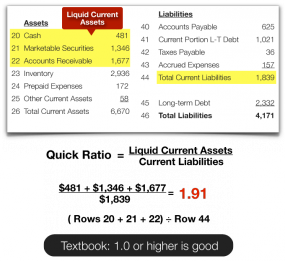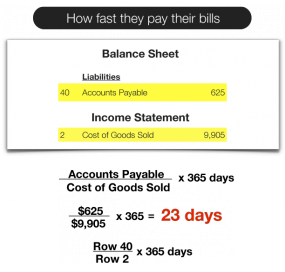Last month I wrote about analyzing the income statement. Today we talk about how to analyze the balance sheet, which is the topic of our fourth video in the series Introduction to Financial Statement Analysis. The videos are available for free on our website, and you can also download a free eBook which has all the information discussed in the videos.
The balance sheet tells us the accounting value of each category of assets, liabilities, and shareholders’ equity on the date of the statement. We look at the balance sheet in order to understand the company’s liquidity, strength, and efficiency.
In the credit industry, liquidity is a key measure, as it lets us know if the company has the cash available to pay its bills. Looking at the amount of cash and liquid investments reported on the balance sheet only tells us part of the picture. We also need to look at what cash requirements the company already has, such as unpaid bills and required loan repayments. The easiest way to do this is to calculate ratios.
The two most common liquidity ratios are the current ratio and the quick ratio. Detailed descriptions of these ratios are provided in the videos, and we show you how to calculate them and how to evaluate the resulting information.
Financial strength is often measured by various debt-to-equity ratios. Companies get capital from two sources: borrowing (debt) and shareholder investments (purchases of stock directly from the company plus any profit from prior periods that is kept in the company, known as retained earnings). Debt needs to be repaid, whereas the company’s shareholders’ equity (whether from investment or retained earnings) typically does not (except for certain Preferred Stock). A company with a lower debt-to-equity ratio (e.g. less debt when compared to equity) is stronger than an identical company with a higher debt-to-equity ratio. The video shows how to calculate two different financial strength ratios and how to evaluate the results.
Evaluating efficiency requires information from both the income statement and the balance sheet. The most common overall efficiency ratios look at profitability versus the capital invested to achieve this profit. Net Income is the most common measure of profitability, and shareholders’ equity or total assets are the two most common capital measures. The higher the ratio, the better company management is doing generating a profit from the capital invested.
We can also look at operating efficiency. This includes looking at how well the company is managing outstanding accounts receivable, inventory investment, and accounts payable. Credit professionals get insights on how fast their invoices will likely be paid by looking at a company’s average day’s payables outstanding. But, it is also a good idea to look at a customer’s receivables to see if there are any indications of future cash flow issues.
Please check out the free videos on our websites. We encourage you to comment below on this blog post and the video series. Please let us know if there are other topics you would like us to cover, and please share any knowledge you have about analyzing financial statements.







![the word regulation in a stylized dictionary [Image by creator from ]](/media/images/Credit_Report_Disputes.max-80x80.png)
![Cover image for New Agent Onboarding Manuals resource [Image by creator from insideARM]](/media/images/New_Agent_Onboarding_Manuals.max-80x80_3iYA1XV.png)


![[Image by creator from ]](/media/images/New_site_WPWebinar_covers_800_x_800_px.max-80x80.png)
![[Image by creator from ]](/media/images/Finvi_Tech_Trends_Whitepaper.max-80x80.png)
![[Image by creator from ]](/media/images/Collections_Staffing_Full_Cover_Thumbnail.max-80x80.jpg)
![Report cover reads One Conversation Multiple Channels AI-powered Multichannel Outreach from Skit.ai [Image by creator from ]](/media/images/Skit.ai_Landing_Page__Whitepaper_.max-80x80.png)
![Report cover reads Bad Debt Rising New ebook Finvi [Image by creator from ]](/media/images/Finvi_Bad_Debt_Rising_WP.max-80x80.png)
![Report cover reads Seizing the Opportunity in Uncertain Times: The Third-Party Collections Industry in 2023 by TransUnion, prepared by datos insights [Image by creator from ]](/media/images/TU_Survey_Report_12-23_Cover.max-80x80.png)
![Webinar graphic reads RA Compliance Corner - Managing the Mental Strain of Compliance 12-4-24 2pm ET [Image by creator from ]](/media/images/12.4.24_RA_Webinar_Landing_Page.max-80x80.png)